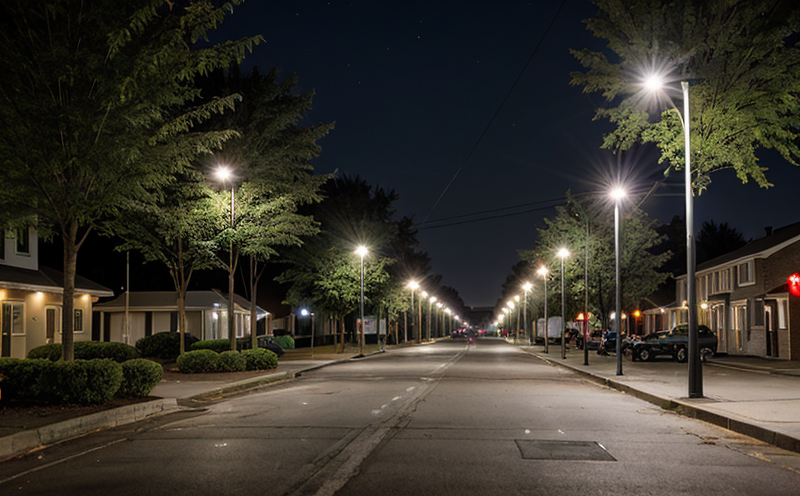IEC 62262 IK Rating Impact Testing of Outdoor Street Lighting Fixtures
The IEC 62262 standard is a crucial document in the lighting industry, providing guidelines for impact testing outdoor street lighting fixtures. This service focuses on ensuring that these fixtures can withstand potential hazards such as falling objects or accidental impacts from vehicles. The primary purpose of this testing is to enhance public safety and longevity by confirming that the fixtures meet stringent durability requirements.
The IEC 62262 standard defines three levels of impact resistance known as IK ratings: IK0, IK1, and IK2. For outdoor street lighting fixtures, a higher IK rating indicates greater resistance to impacts from falling objects or accidental collisions. Testing typically involves subjecting the fixture to an impact from a specified mass at a specific velocity. The fixture is subjected to this impact under controlled conditions.
Before testing can begin, the specimen must be prepared according to the standards outlined in IEC 62262. This includes ensuring that all components are assembled correctly and that the fixture's mounting base is secure. During the test, a calibrated pendulum or similar apparatus delivers an impact force on the designated part of the lighting fixture. The acceptance criteria for this test include no visible cracks, fractures, or other physical damage to the fixture.
Understanding the importance of this testing requires insight into real-world applications. For instance, in urban environments, streetlights can be exposed to a variety of potential impacts from falling branches, birds, and even accidental collisions with vehicles. Testing these fixtures ensures that they will continue to function safely and reliably under such conditions.
The scope of the IEC 62262 IK Rating Impact Testing also encompasses the evaluation of the fixture's components. This includes the housing, mounting base, and any other parts that could be subjected to impact forces. The test aims not only at ensuring structural integrity but also at preventing potential hazards such as electrical shorts or failures in the light source.
It is essential to note that this testing is not just about compliance with standards; it's a critical step in enhancing public safety and reducing maintenance costs. By identifying any weaknesses early on, municipalities can make informed decisions about which fixtures require immediate replacement or repair.
| IK Rating | Description | Typical Impact Force (N) | Impact Velocity (m/s) |
|---|---|---|---|
| IK0 | No specific impact resistance requirements. | - | - |
| IK1 | Protection against impacts from falling objects up to 5 kg at a speed of 2 m/s. | 4,906 N | 2.04 m/s |
| IK2 | Enhanced protection against impacts from falling objects up to 15 kg at a speed of 3 m/s. | 14,718 N | 3.06 m/s |
The above table outlines the impact forces and velocities associated with each IK rating level, providing a clear understanding of the increasing levels of protection required by higher ratings.
In summary, IEC 62262 IK Rating Impact Testing is a vital process in ensuring that outdoor street lighting fixtures are robust enough to withstand potential impacts. This testing not only enhances public safety but also ensures long-term reliability and cost-effectiveness for municipalities and other stakeholders involved in the design, installation, and maintenance of these critical infrastructure components.
Scope and Methodology
The scope of this testing includes evaluating the impact resistance of outdoor street lighting fixtures according to the IEC 62262 standard. The methodology involves subjecting the fixture to a controlled impact using calibrated equipment, ensuring that all components are prepared in accordance with the specified standards.
- Calibration of test equipment
- Preparation of the specimen for testing
- Application of the impact force on designated parts of the fixture
- Evaluation of the fixture's response to the impact force
The methodology is designed to ensure that all tests are conducted under controlled conditions, allowing for consistent and reliable results. This approach guarantees that the testing process adheres strictly to international standards while providing valuable insights into the performance characteristics of the fixtures.
For the purpose of this test, we use calibrated pendulums or similar apparatus that can deliver precise impact forces at specified velocities. The equipment used in these tests is regularly maintained and calibrated to ensure accurate results. This ensures that the testing process is both reliable and repeatable.
The acceptance criteria for this test are based on visual inspection of the fixture after the impact has been delivered. Any visible cracks, fractures, or other physical damage would indicate a failure of the test. The goal is to have no such signs of damage post-impact, ensuring that the fixture can withstand typical environmental stresses.
Benefits
Enhanced public safety by ensuring fixtures are robust against impacts from falling objects or accidental collisions.
Increased reliability and longevity of the lighting fixtures, reducing maintenance costs over time.
Improved compliance with international standards, ensuring consistent quality across different projects.
Identification of potential weaknesses early on, allowing for informed decisions about fixture replacement or repair.
Greater confidence in the performance and durability of lighting fixtures, leading to better planning and resource allocation.
Easier demonstration of compliance with local regulations and standards, streamlining the approval process for new projects.
Customer Impact and Satisfaction
Municipalities can make informed decisions about which fixtures require immediate replacement or repair, reducing downtime and associated costs.
Testing ensures that the lighting system meets stringent durability requirements, enhancing public trust in infrastructure quality.
By identifying potential issues early on, customers benefit from a more efficient maintenance schedule, minimizing disruptions to daily operations.
The process of testing and certification provides transparency and reassurance regarding product performance, leading to increased customer satisfaction.
Through this service, we aim to provide our clients with the highest level of assurance that their lighting fixtures will perform reliably under real-world conditions. This comprehensive approach ensures that customers are well-informed about the quality and durability of the fixtures they choose for their projects.





